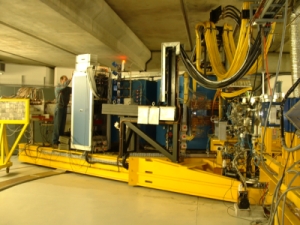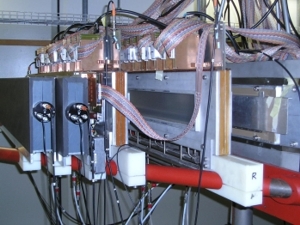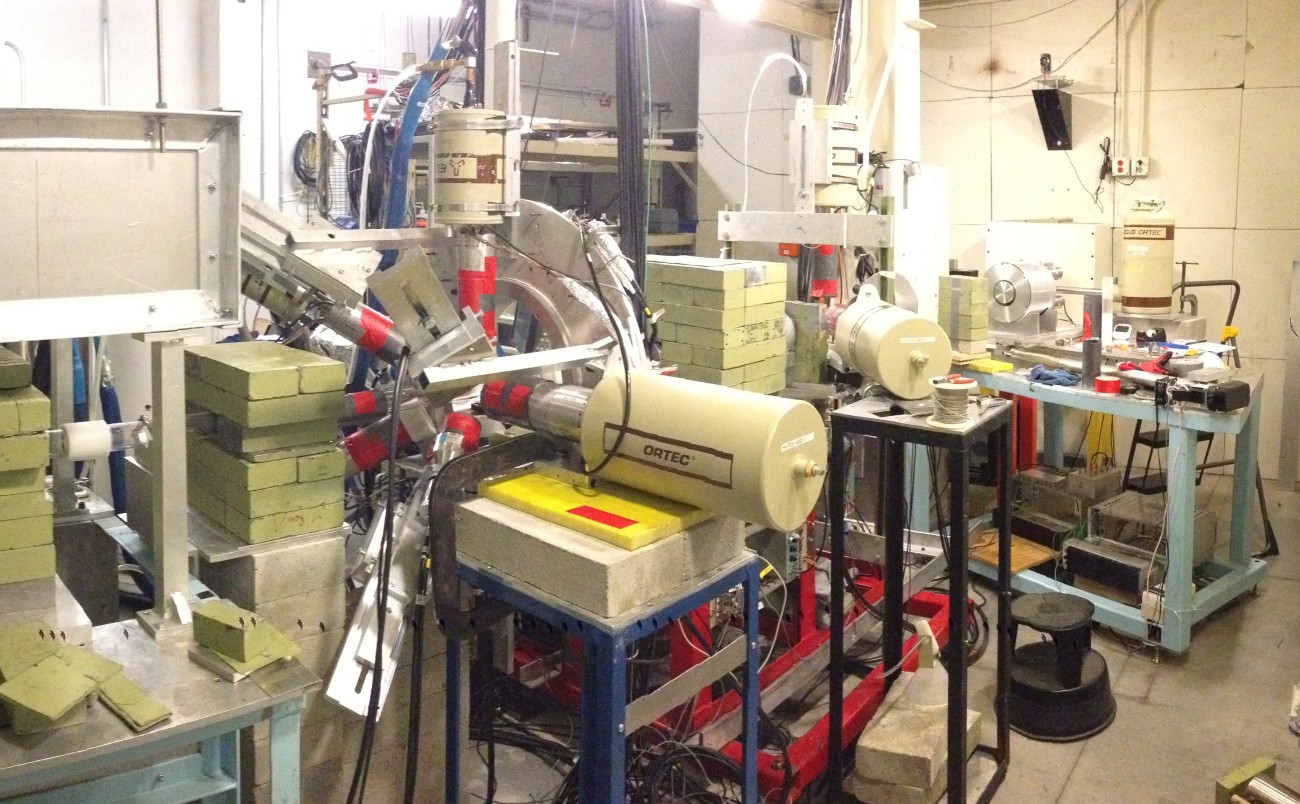Our group performs experiments at the Argonne National Laboratory near Chicago.
It is the location of the Gammasphere spectrometer, an array of up to 110 high purity Germanium detectors arranged in a 4pi geometry.
We use Gammasphere's angular resolution and high gamma ray detection efficiency for the study of collective excitations of atomic nuclei by the means of experiments with the projectile Coulomb excitation technique.
Our experiments yield complete sets of reduced transition probabilities between the low lying states of atomic nuclei.
Our main topic of interest is the study of the quadrupole excitation of mixed proton-neutron symmetry and its properties.
The international Facility for Antiproton and Ion Research (FAIR) is currently being built at Darmstadt. The international investment for this major research infrastructure will amount to approximately 1.5 billion EUR.
This facility will comprise of an accelerator complex for intense beams of heavy ions near the campus of the present GSI Helmholtzzentrum für Schwerionenforschung GmbH.
Apart from other topics the FAIR facility will address fore-front questions in the fields of nuclear structure physics, nuclear astrophysics and reactions.
These activities are summarized in the NUSTAR-pillar of FAIR.
Our group is strongly involved in the realization of the NUSTAR project at FAIR.
We are leading the German project that comprises the entire activities at German universities supported for the NUSTAR project by the German Federal Ministry for Education and Research (BMBF).
We are leading the Gamma-ray Spectroscopy group at GSI and we are involved in the realization of the future HISPEC/DESPEC experiments at FAIR for highest resolution gamma-ray spectroscopy at relativistic radioactive heavy-ion beams.
Until the completion of FAIR in the year 2019 we are part of the PRESPEC-experimental campaign that enables us to further push our experimental technology until the HISPEC/DESPEC experiments will start operation.
At the ISOLDE facility at CERN, radioactive ion beams of isotopes all across the chart of nuclides are produced by injecting 1.4 GeV protons on a thick primary target. The produced ions are extracted by an ion source and mass separated using the ISOL method. The selected ions are post-accelerated by REX- and super conducting HIE-accelerators up to an energy of 10 MeV/A and delivered to the experminental station, where they impinge on a thin secondary target. Around this target chamber (see picture to the right) the high-purity germanium (HPGe) detector array MINIBALL (see picture below) and a double-sided silicon strip detector (DSSD) are placed for high energy resolution gamma-ray spectroscopy and particle detection, respectively. A so-called plunger device for the measurement of excited-state lifetimes in the pico-second regime and magnetic moments can replace the target chamber. These experimental setups are used by our group for projectile Coulomb excitation experiments and lifetime measurements using Doppler-shift to study the nuclear structure of rare nuclei.
Upcoming experiments:
- Configurational Isospin Polarization in 136Te – projectile Coulomb excitation and DSAM (IS596).
Recent experiments:
- Shape co-existence in 96Kr – Coulomb-nuclear excitation (IS644, 2018).
Previous experiments:
- Nuclear moments studies of 28Mg – g-factor measurement (TDRIV) (IS628, 2017).
- Collective mixed-symmetry quadrupole states of N = 80 isotones (140Nd, 142Sm) – projectile Coulomb excitation (IS546, 2017).
- Investigation of the 100Sn region – transfer reaction and Coulomb excitation (IS562, 2016-2017).
- Collective first quadrupole states of N = 80 isotones (140Nd, 142Sm) – projectile Coulomb excitation (IS496, 2012).
The High Intensity γ-ray Source (HIγS) at the Duke Free Electron Laser Laboratory provides a quasi mono-energetic, linearly polarized photon beam up to 100 MeV. Since 2012, the γ3 setup is the prime detector array used for photon scattering experiments. It picks up the idea of a parity sensitive arrangement of high-purity Germanium (HPGe) detectors linked with an array of Cerium doped Lanthanum-Bromide (LaBr3:Ce) detectors to enable γγ-coincidence measurements. The deexciting transitions follow different angular distributions depending on the spin and parity quantum numbers of the excited state. The γ3 setup enables the measurment of spin and parity quantum numbers, energy eigenvalues, intensity branching ratios, and multipole mixing ratios.
Current experiments:
- investigation of the E2 decay behavior and search for new decay channels of the scissors mode of 154Gd
- study of the dipole strength distribution and the Pygmy Dipole Resonance (PDR) of 150Nd and 154Gd
Previous experiments:
- energy separation of the parity doublet of 20Ne (2011)
- search for exotic decay channels of the scissors mode of 76Ge, 150Nd, 150Sm, 156Gd, and 162,164Dy (2011-2016)
- study of the properties of the Pygmy Dipole Resonance (PDR) of 50Ti, 50,54Cr, 94Zr, 128,130Te, 140Ce, and 164Dy (2010-)
- investigation of the dipole strength distribution up to the neutron separation threshold of 40Ar, 76Se, 76Kr, and 164Dy (2012-2016)
- …
At the Institute of Physics and Nuclear Engineering in Bucharest a 9 MV FN Tandem accelerator can provide a wide variety of stable isotopes as projectiles, mainly used for nuclear structure physics and nuclear reaction physics experiments.
The main device for gamma ray spectroscopy is the RoSphere detector array, typically in a mixed configuration of high-purity germanium (HPGe) and cerium-doped lanthanum-bromide (LaBr3:Ce) detectors. This detector setup makes it possible to study gamma-gamma coincidences and determine the lifetimes of excited nuclear states with the fast electronic scintillation timing technique (FEST) in the range of a few ten ps to ns or the Doppler-shift attenuation method (DSAM) in the fs to ps range. Furthermore a plunger device is available to measure lifetimes with the recoil-distance Doppler-shift (RDDS) technique (ps range).
Previous experiments:
- Shape-phase transition at 98Zr – measurement of the B(E2;2+1→0+1) value with the RDDS method (2018)
- Shape-phase transition at 98Zr – Measurement of excitation function for a future Plunger experiment (2017)
- Lifetime measurement of short-lived states of 150Gd (2015)
- Search for a new signature for a quantum shape-phase transition. FEST lifetime measurement of 152Gd (2014)
- Precision Half-life Measurements of Excited States in 146Sm (2014)
- Fast Timing Lifetime Measurements of 2+1 States in Hf Isotopes (2013)
The research reactor of the Institut Laue-Langevin (ILL) is located in Grenoble, France. It has the most intense continuous neutron flux in the world. The flux in the reactor is approximately 1.5 ·1015 n/cm2·s. There is a large number of neutron guides for transferring the neutrons from the reactor several meters away to the experimental areas. Those neutrons can be use for nuclear structure and nuclear reaction physics experiments.
Neutrons with different characteristics can be provided, like:
- Ultracold neutrons (PF2 facility)
- Polarised cold neutrons (PF1B facility)
- Thermal neutrons (S18 facility)
There are several devises which can be used to investigated the produced exotic nuclei after fission or neutron capture reactions. Some of them, used in the past by our group, are:
- The FIPPS HPGe array for angular correlation and spectroscopic properties of exotic nuclei.
- The PN1 (LOHENGRIN) recoil mass spectrometer for studying the properties of the exotic isotopes produced during the fission process.
- The PN3 – gamma-ray spectrometers GAMS4 and GAMS5 for high energy-resolution and lifetime experiments.
Previous experiments:
- Uranium-fission FIPPS run – Gamma-spectroscopy measurements of 233U and 235U fission products (2018).
- Low-spin spectroscopy of 205Pb by thermal neutron capture reactions 204Pb(n,gamma)205Pb (2018).
- A gamma-gamma angular correlation measurement of 168Er after (n,gamma) with the FIPPS array (2016).
- Precision measurement of the 2+β→0+β intensity in 158Gd (2015).
- Population of dipole states in 96Zr and 136Xe via β-decay (2015).
- EXILL&FATIMA campaign – Fast-timing and gamma-specroscopy measurements of 235U and 241Pu fission products (2013).

The iThemba Laboratory for Accelerator Based Sciences is located in Cape Town, South Africa and addresses many different areas like particle radiotherapy for the treatment of cancer, supply of accelerator-produced radioactive isotopes and basic and applied research using particle beams. Our focus is on the K600 magnetic spectrometer which offers the possibility to investigate the structure of nuclei in high-resolution proton scattering experiments. It consists of five magnets namely a quadrupole, two dipoles and two trim coils. Due to dispersion matching techniques an energy resolution of 25keV (FWHM) is possible using a proton beam up to an energy of 200 MeV. The detector system on the focal plane consists of several multi-wire drift chambers which allow to reconstruct the energies and the scattering angles of the deflected protons.

Using the K600 magnetic spectrometer we mainly investigate „Mixed-Symmetry States“ and Giant Resonances like the Isovector Dipole Resonance or the Isoscalar Quadrupole Resonance. The cross section measured in proton scattering exhibits an useful additional observable to understand the structure and the properties of these two classes of nuclear excitations.
Very recently a new 0° scattering facility has been developed at iThemba LABS. Proton scattering at an scattering angle of 0° degrees offers the unique possibility to measure electromagnetic transition strength below and above the neutron separation threshold with one single experiment.
At the National Institute of Nuclear Physics in Legnaro, Italy, four different accelerators can be used to produce energetic stable ion beams up to 197Au. The laboratory is equiped with different types of spectrometers to detect gamma radiation (e.g. GASP, AGATA-Demonstrator til 2011) or charged particles (PRISMA). The main focus of our research activities at Legnaro are precise lifetime measurements based on the Doppler-Shift-Attenuation-Method (DSAM) or the Recoil-Distance-Doppler-Shift (RDDS) technique.
At Legnaro our research group has obtained first results with the AGATA-Demonstrator, the feasability study and primary stage of the 4pi-gamma-spektrometer AGATA (http://www-w2k.gsi.de/agata/) the latter integrale part of the FAIR experiment HISPEC. The state-of-the-art HPGe crystals of the AGATA type are 36fold segmented and offer a high detection efficiency for energetic gamma rays combined with a position resolution of approx. 3 millimeters (after pulse-shape analysis) and tracking possibilites. These unique features we use to delevelop an entirely new DSA algorithm for continuous angles which significantly improves the existing DSA analysis.
Website INFN Legnaro:
Experiment(s):
- „Precision lifetime study in the neutron-rich N = 84 isotone Ba from DSAM measurements following Coulomb-barrier α-transfer reactions on a 136Xe beam with the AGATA-Demonstrator“
Staff:
Jörg Leske
Christian Stahl
Unsere Forschungsgruppe ist in führender Rolle an der PreSPEC- Experimentkampagne am FRS der GSI beteiligt, die ein wichtiger Entwicklungsschritt für das zukünftige FAIR-Experiment HISPEC (High-resolution In-flight SPECtroscopy) darstellt. In diesem Programm sollen im Rahmen der NuSTAR-Kollaboration wichtige Erkenntnisse für die Kernstrukturforschung aus Gammaspektroskopie sehr exotischer Atomkerne gewonnen werden. Als Besonderheit wird dabei die sogenannte In-Flight-Methode zum Einsatz kommen, bei der die zu untersuchenden Kerne in einer Fragmentationsreaktion erzeugt und anschließend in einem Fragmentseparator (Super-FRS) extrahiert werden. Dabei haben die erzeugten Ionen Geschwindigkeiten bis zu 60% der Lichtgeschwindigkeit. Diese hochenergetischen Ionen treffen auf ein Target und lösen dort eine Sekundärreaktion aus, die es ermöglicht über Gamma- und teilchenspektroskopische Methoden, Zugang zu den Kernobservablen zu erhalten. HISPEC wird als eines der ersten Experimente an FAIR mit Strahlen vom Super- FRS bedient und wird somit zu den ersten Ergebnissen an FAIR überhaupt beitragen werden.
Zum geplanten Programm gehören Experimente, die Aufschluss über die Entwicklung und Modifikation der Schalenstruktur mit zunehmendem Neutronenüberschuss geben, den Zusammenbruch der Isospin-Symmetrie untersuchen, die Grenzen der Stabilität an den Abbruch- kanten erforschen sowie kollektive Phänomene in bisher unerforschten Massenregionen und elektrische und magnetische Dipolstärken in exotischen Atomkernen im Focus haben. Für das Experimentprogramm an PreSPEC kommt eine weltweit einmalige Kombination von intensiven exotischen Kernen bei relativistischen Energien vom FRS der GSI und einem gamma-Spektrometer höchster Sensitivität durch den Einsatz von AGATA gamma-Trackingdetektoren zum Einsatz.
Website PreSPEC: http://www-linux.gsi.de/~wolle/PreSPEC/index.html
Technische Entwicklungen und Mitarbeit:
Plamen Boutachkov – Projektleitung
Michael Reese : PreSPEC data analysis and AGATA software integration, FRS
Liliana Cortes: Szintillatoren (FINGER, HECTOR)
Damian Ralet: EDAQ-Hardware
Edana Merchan: Analyse-Software (Debugging)
Pushpendra Singh: AGATA/LYCCA-Cabling, Power
Polarized proton scattering at 300 MeV at 0° at the Research Center for Nuclear Physics (RCNP) in Osaka, Japan, has been experimentally established as a tool to extract the properties of low-energy electric and magnetic dipole modes in heavy nuclei. A decomposition of the (p, p') cross sections according to their electric or magnetic character can be achieved in two independent ways by either measuring angular distributions including 0° or by using a polarized beam and measuring polarization transfer observables to distinguish spinflip and non-spinflip contributions.
A series of collaborative experiments have already been performed at the two-arm spectrometers, Grand Raiden and Large Acceptance Spectrometer (LAS). They are characterized by high resolution (D/M=37,000) and large acceptance (20 msr), respectively. The Grand Raiden can analyze up to 1.4 GeV protons (450 MeV tritons).
The Focal Plane Polarimeter (FPP) for Grand Raiden can analyze the polarization of protons with an efficiency of about 3% and an effective analyzing power of about 40%. It can measure the longitudinal component of the polarization vector with the DSR magnet.
In the past few years the following experiments have already been performed at the Grand Raiden/LAS/FPP setup:
- 2006+2008
208Pb(p,p') with polarized protons at 0 deg and very forward angles (Iryna Poltoratska, Pygmy Resonance and Neutron Skin) - 2008+2009
120Sn(p,p') with polarized protons at 0 deg and very forward angles (Anna Maria Krumbholz, Pygmy Resonance) - May 2011
154Sm(p,p') with polarized protons at 0 deg (Andreas Krugmann+Dirk Martin (144Sm), Spin-M1 Resonance and the role of deformation) - April+May 2012
96Mo(p,p') with polarized protons at 0 deg (Dirk Martin, Radiative Strength Function in 96Mo: A Test of the Axel-Brink Hypothesis) - April+May 2012
70Zn(p,p') at 0 deg (???, Dipole Response in 70Zn and Shell Evolution in Neutron-Rich Nuclei)




















